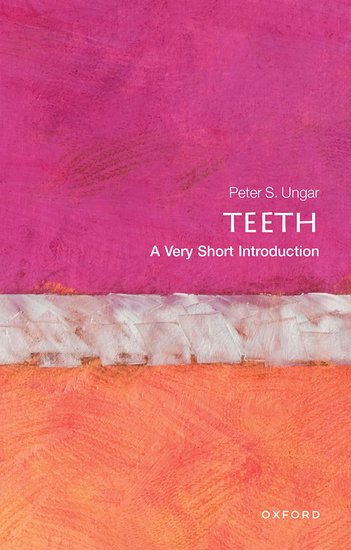Home >
A Very Short Introduction >
Teeth (Medical)
A Very Short Introduction | Medical
Teeth
ISBN: 9780199670598
Series: A Very Short Introduction
Teeth (Medical)
A Very Short Introduction Teeth (Medical) Media > Books > Non-Fiction > Education Books Expect Delays of Up to 4 Weeks| Order Below |
ISBN
9780199670598 (10-digit ISBN: 0199670595)
- Description
- Key Features
- Series Description
- Table of Contents
- Presents the story of teeth - from the earliest tooth-bearing fishes hundreds of millions of years ago through amphibians, reptiles and, ultimately, mammals
- Considers the anatomy and variety of teeth and the important role they play
- Explores the variety of tooth forms in living animals
- An ideal introduction to students of zoology, anthropology, and dentistry courses
Teeth are amazing - the product of half a billion years of evolution. They provide fuel for the body by breaking apart other living things; and they must do it again and again over a lifetime without themselves being broken in the process. This means that plants and animals have developed tough or hard tissues for protection, and teeth have evolved ways to sharpen or strengthen themselves to overcome those defences. And just as different jobs require different tools, animals with different diets have different shaped teeth to deal with the variety of foods that they eat.
In this Very Short Introduction, Peter S. Ungar, an award-winning author and leading scientist, presents the story of teeth. Ungar outlines the key concepts, including insights into the origin of teeth and their evolution. Considering why teeth are important, he describes how they are made, and how they work, including their fundamental importance in the fossil record. Ungar finishes with a review of mammal teeth, looking at how they evolved and how recent changes to our diet are now affecting dental health.
Oxford's Very Short Introductions series offers concise and original introductions to a wide range of subjects--from Islam to Sociology, Politics to Classics, Literary Theory to History, and Archaeology to the Bible.
Not simply a textbook of definitions, each volume in this series provides trenchant and provocative--yet always balanced and complete--discussions of the central issues in a given discipline or field. Every Very Short Introduction gives a readable evolution of the subject in question, demonstrating how the subject has developed and how it has influenced society. Eventually, the series will encompass every major academic discipline, offering all students an accessible and abundant reference library.
Whatever the area of study that one deems important or appealing, whatever the topic that fascinates the general reader, the Very Short Introductions series has a handy and affordable guide that will likely prove indispensable.
Please note: As this series is not ELT material, these titles are not subject to discount.
1: Teeth matter
2: Types and parts of teeth
3: What teeth do: food and feeding
4: The origin of teeth and teeth in non-mammals
5: The evolution of teeth in mammals
6: Mammal teeth today
7: Human teeth and their history
8: Endless forms
Further reading
Teeth are amazing - the product of half a billion years of evolution. They provide fuel for the body by breaking apart other living things; and they must do it again and again over a lifetime without themselves being broken in the process. This means that plants and animals have developed tough or hard tissues for protection, and teeth have evolved ways to sharpen or strengthen themselves to overcome those defences. And just as different jobs require different tools, animals with different diets have different shaped teeth to deal with the variety of foods that they eat.
In this Very Short Introduction, Peter S. Ungar, an award-winning author and leading scientist, presents the story of teeth. Ungar outlines the key concepts, including insights into the origin of teeth and their evolution. Considering why teeth are important, he describes how they are made, and how they work, including their fundamental importance in the fossil record. Ungar finishes with a review of mammal teeth, looking at how they evolved and how recent changes to our diet are now affecting dental health.
Key Features
- Presents the story of teeth - from the earliest tooth-bearing fishes hundreds of millions of years ago through amphibians, reptiles and, ultimately, mammals
- Considers the anatomy and variety of teeth and the important role they play
- Explores the variety of tooth forms in living animals
- An ideal introduction to students of zoology, anthropology, and dentistry courses
Series Description
Oxford's Very Short Introductions series offers concise and original introductions to a wide range of subjects--from Islam to Sociology, Politics to Classics, Literary Theory to History, and Archaeology to the Bible.
Not simply a textbook of definitions, each volume in this series provides trenchant and provocative--yet always balanced and complete--discussions of the central issues in a given discipline or field. Every Very Short Introduction gives a readable evolution of the subject in question, demonstrating how the subject has developed and how it has influenced society. Eventually, the series will encompass every major academic discipline, offering all students an accessible and abundant reference library.
Whatever the area of study that one deems important or appealing, whatever the topic that fascinates the general reader, the Very Short Introductions series has a handy and affordable guide that will likely prove indispensable.
Please note: As this series is not ELT material, these titles are not subject to discount.
EASY ORDER FORM
PRICES LISTED INCLUDE CONSUMPTION TAX
Price Before Tax:
¥1,790


